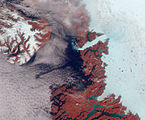What
we are currently observing in the Arctic has reminded me of this
article from Robertscribbler from the 2013 melt season.
The
photo is still on my Facebook page.
North Pole Melting: Ice Camera 2 Swims as Camera 1 Gets its Feet Wet
Camera
2 in deep water at North Pole. Image sourc: APL
25
July, 2015
This
summer has seen a great number of extraordinary events resulting from
human caused climate change. These include massive heat dome high
pressure systems setting off record droughts, fires and heat
waves, Arctic
temperatures rocketing into the 80s and 90s, Europe
and Canada suffering some of their worst flooding events in
history and
a crazy
US weather system moving backwards against the prevailing weather
pattern for more than 3,000 miles.
Add to these record events a substantial melting of ice in the
Arctic’s most central regions, and you end up with rather strong
proofs that our greenhouse gas emissions have permanently altered the
word’s weather.
From
late May to early July, a persistent Arctic cylone (PAC 2013) first
fractured ice near the North Pole, then consistently widened and
melted the gap it created. Now a large triangle of very thin ice
extends from the North Pole south and eastward toward the Laptev Sea.
The section of meter or less thickness keeps widening even as gaps
continue opening in the ice and melt ponds form over many of the
remaining flows.
Further
north and on toward the western side of the North Pole, two cameras
supplied by the Applied Physics Lab and funded through a National
Science Foundation grant are performing their own daily recording if
this major melt event. The melting, which from the satellite, appears
to have turned the sea ice near the North Pole into swiss cheese has
had a marked effect on visible surface conditions as well.
Of
the two ice cameras, #2 so far has seen the most action. On
about July 13th, melt puddles began to form in the region of Camera
#2. By earlier this week, the camera was deep in a growing pool of
ice melt. By today, the water had deepened further covering all the
markers surrounding both the camera and its related sensor buoy.
Water now appears to be about 3 feet deep and the pond just keeps
growing and growing (you
can read more about the saga of Ice Camera #2 here).
But
now, Ice Camera #1 appears to be about to suffer the same fate. Over
the past couple of days, melt ponds have now also been forming in the
vicinity of Camera #1. You can see this new set of melt puddles here:
Note
the melt puddle snaking its way behind the wind vane visible in the
camera’s field of view and on toward Camera #1 itself. If
conditions at this camera are similar to those near Camera #2, then
we can expect Carema #1 to be swimming in about ten days time.
With
temperatures remaining above freezing for much of the Central Arctic,
melt conditions have tended to dominate. Now, most of the remaining
ice is rather weak, with a thickness of about 2 meters or less. And
with so much of this thin ice in areas near the North Pole, a
possibility exists that much of this region will melt out over the
next 6 weeks or so.
As
for the Ice Cams? It appears that #1 may soon join #2 in the drink.
The following is from Wikipedia
Melt
ponds are
pools of open water that form on sea
ice in
the warmer months of spring and summer. The ponds are also found
on glacial ice
and ice
shelves.
Ponds of melted water can also develop under the ice.
Melt
ponds are usually darker than the surrounding ice, and their
distribution and size is highly variable. They absorb solar
radiation rather
than reflecting it as ice does and, thereby, have a significant
influence on Earth's
radiation balance.
This differential, which had not been scientifically investigated
until recently, has a large effect on the rate of ice melting and the
extent of ice cover.[1]
Melt
ponds can melt through to the ocean's surface.[2] Seawater entering
the pond increases the melt rate because the salty water of the ocean
is warmer than the fresh water of the pond. The increase in salinity
also depresses the water's freezing
point.
Water
from melt ponds over land surface can run into crevasses or moulins –
tubes leading under ice sheets or glaciers – turning
into meltwater.
The water may reach the underlying rock. The effect is an increase in
the rate of ice flow to the oceans, as the fluid behaves like
a lubricant in
the basal
sliding of
glaciers.[3]
Effects of melt ponds[edit]
See
also: Glacial
motion
The
effects of melt ponds are diverse (this subsection refers to melt
ponds on ice sheets and ice shelves). Research by Ted Scambos, of
the National
Snow and Ice Data Center,
has supported the melt water fracturing theory that suggests the
melting process associated with melt ponds has a substantial effect
on ice
shelf disintegration. [4] Seasonal
melt ponded and penetrating under glaciers shows seasonal
acceleration and deceleration of ice flows affecting whole
icesheets.[5] Accumulated
changes by ponding on ice sheets appear in the earthquake record of
Greenland and other glaciers:[6] "Quakes
ranged from six to 15 per year from 1993 to 2002, then jumped to 20
in 2003, 23 in 2004, and 32 in the first 10 months of
2005."[7] Ponding
in the extreme is lakes and lakes in association with glaciers are
examined in the particular case of the Missoula
Floods.
Given what we are observing I have my doubts that what we are observing in the Arctic are meltpools.
The ice seems too unstable and thin to support them.
But that is only my considered opinion












No comments:
Post a Comment
Note: only a member of this blog may post a comment.